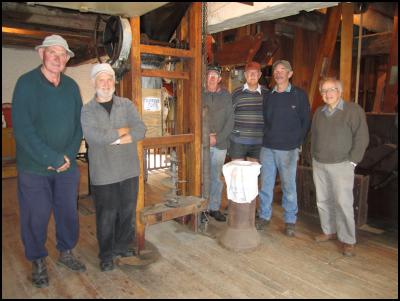Flour power
18 October 2013
Flour power

One of North Otago’s most significant historic sites opens to the public again next week, once more providing a window to an industry that shaped the region.
Clarks Mill is an imposing presence on the landscape of Maheno in rural North Otago. Built from Oamaru limestone cut from a nearby hill, the four-storey mill is a simple yet striking building and a rare reminder of an industry that once thrived in the region.
Built in 1866 as part of nearby Totara Estate, it is a rare example in New Zealand of an originally water-powered flour mill with early machinery still substantially intact.
“The mill is a unique representation of the rise and decline of wheat growing and flour milling in North Otago, which was a huge part of the district’s economy in the 19th and 20th centuries,” explains Property Manager Anne Sutherland. “Clarks Mill is part of the wider picture of Oamaru’s history. It’s one of those key places that give Oamaru its special place in the world.”
Designed by James Balfour Melville, the mill houses a significant and rare collection of working mill machinery dating from the 19th century through to the post-war period. The site includes the original mill race which runs from the intake gate at the Kakanui River through a tunnel carved from an outcrop of stone and along a stone-lined channel. It also features the railway siding that was built in 1877 to connect the mill to the main trunk line. In addition, the site includes the Miller’s House and a small cottage built from Oamaru stone about the same time as the mill. The cottage, now known as Smokey Joes, was the brainchild of Allan Clark who was inspired by the nightclubs he saw while on service in the Middle East during World War II. After returning to New Zealand he converted the company office into a “music hall”, decorated with painted Hawaiian scenes and war memorabilia. It was used as a venue for parties and private functions as well as club rooms for various sporting organisations.
Today Clarks Mill is operated by volunteers who guide visitors through the building and show them the machinery with an explanation of the flour-milling process. But it’s when the machinery is turned on that the real education starts. “It’s a combination of seeing and hearing but also feeling the whole building shake. The noise and the belts going around... it is just something else,” says Anne.
Volunteer Harry Steenson has had a 30-year connection with the mill. He says the reaction of visitors when the machinery is turned on is often priceless. “They are thrilled. There is a buzz of action with people running up flights of steps to see different parts of it operating. The whirl and vibration catch them up.” The ongoing
care and restoration project has been a true labour of love for the small volunteer team.
Anne says that Clarks Mill is a wonderful education resource. “Although the technology has developed over 150 years, there is a direct relationship between what was happening then and now. We have an opportunity at the mill to use it as a springboard for developing further the exploration of how the agricultural industry developed in New Zealand.”
And that opportunity is being seized upon. “This year we are kicking off an oral history of the mill, in partnership with the North Otago Museum, to capture its stories from the people who remember being there or were part of the restoration.”
Clarks Mill will be open on Sunday afternoons (1pm-3pm) from Sunday 27 October, with the machinery operating on the last Sunday of each month – including on the 27th October. In addition, it will be open every day in February and during that month the mill machinery will run on Thursdays at 11am and Sundays at 2pm.
“Increasing our opening hours and running time is all part of sharing the wonder of an agricultural marvel with a new generation,” says Anne.
Clarks Mill
1017 Alma-Maheno Road (State Highway One), Maheno (12km South of Oamaru)
Opening hours:
The mill opens on Sunday afternoons, 27 October to April, 1pm – 3pm with the machinery operating on the last Sunday of each month, including on 27th October. Tours at other times can be arranged on request. The mill will be open every day in February 2014 with the machinery operating 11am Thursdays and 2pm Sundays.
Cost:
NZHPT member: Free entry (to become a member visit www.historic.org.nz/membership)
Non-member: $10 (Machinery
Operating
$15)
ends


 Gordon Campbell: On Why We Can’t Survive Two More Years Of This
Gordon Campbell: On Why We Can’t Survive Two More Years Of This Peace Action Ōtautahi: Bridge Of Remembrance Peace Protest
Peace Action Ōtautahi: Bridge Of Remembrance Peace Protest National Wetland Trust: Public Asked To Help Prevent Fires In Wetlands This Summer
National Wetland Trust: Public Asked To Help Prevent Fires In Wetlands This Summer Lillian Hanly, RNZ: The Year In Politics - Stories That Dominated The Headlines In 2024
Lillian Hanly, RNZ: The Year In Politics - Stories That Dominated The Headlines In 2024 Waikato Regional Council: Studies Open Door To Mercury Islands Underwater World
Waikato Regional Council: Studies Open Door To Mercury Islands Underwater World Office of the Privacy Commissioner: Christmas Is About Giving, But Don’t Give Up Your Privacy
Office of the Privacy Commissioner: Christmas Is About Giving, But Don’t Give Up Your Privacy The Rail Advocacy Collective: Chris Trotter - Running Us Off The Rails
The Rail Advocacy Collective: Chris Trotter - Running Us Off The Rails


